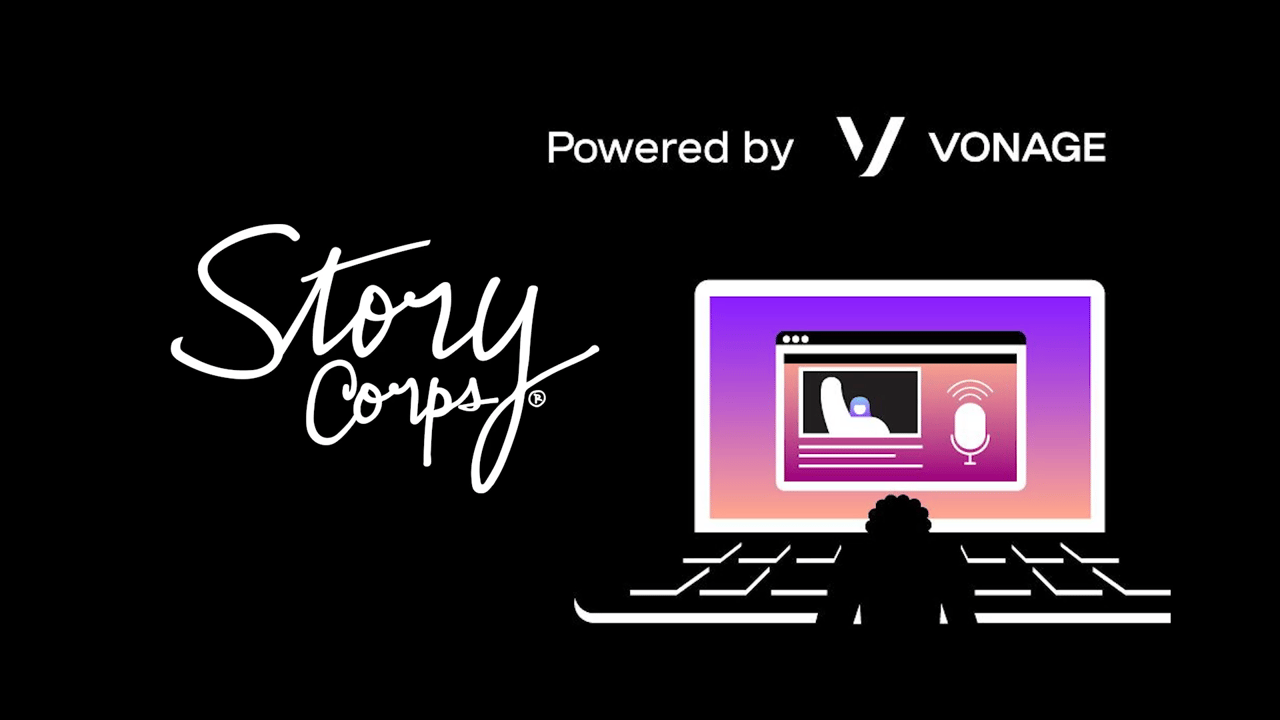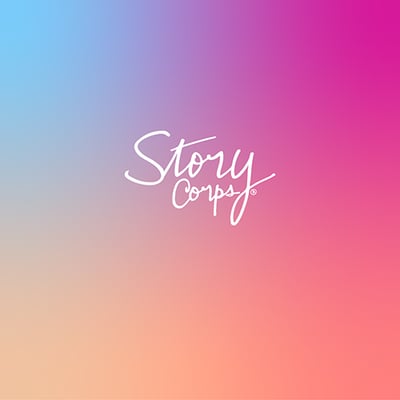StoryCorps Transcends Social Distancing and Keeps Personal Storytelling Alive With Vonage Video API
By partnering with Vonage, StoryCorps used digital innovation and a dedication to their mission to overcome the social barriers of a pandemic.

Challenge
When COVID-19 shut down StoryCorps’ in-person recording spaces, the story-sharing organization needed a digital solution to allow people to continue recording their stories.Solution
StoryCorps Connect, a digital recording platform powered by the Vonage Video APIResults
More than 10,000 people across all 50 U.S. states and 15 other countries have recorded and preserved their stories through StoryCorps Connect.For nearly two decades, StoryCorps has been on a mission to capture and preserve humanity’s stories—intimate, face-to-face conversations where people from all backgrounds share life experiences with a loved one. The nonprofit organization’s work has brought together more than 600,000 people and produced thousands of stories that are archived in the U.S. Library of Congress. Select stories are even broadcast nationwide on National Public Radio. (There’s no official count on the number of tears shed while listening to these moving StoryCorps stories, but a conservative estimate would be gazillions.)
How StoryCorps forged ahead with its noble mission in 2020 is an amazing story that would be worthy of its own archive. It’s a tale of digital innovation and dedication overcoming the social barriers of a pandemic. This is the inside story of how StoryCorps used communications technology to not only maintain but expand its operation in the face of COVID-19.
… Then COVID-19 Hit
2020 held a lot of promise for StoryCorps’ Mobile Tour Site Manager Eunice Cho and Martin Olson, director of digital and technical innovation. Both were ready to play key roles in pushing the organization’s purpose forward.
As a Site Manager—which she’ll tell you is “the coolest job”—Eunice would help coordinate the 10-city tour of StoryCorps’ MobileBooth, a converted Airstream trailer that serves as a recording studio on wheels. At each stop, facilitators like Eunice would invite people from the community to come inside and record their conversations.
Martin, StoryCorps’ director of digital and technical innovation, was tasked with managing its massive story repository while exploring ways to make it more accessible to the public. Giving people the tools to record their stories independently from StoryCorps’ physical spaces was also on his to-do list, but not as high a priority. Then COVID-19 hit, social distancing restrictions took effect, and priorities changed.
“The day the pandemic was declared, I had been traveling,” said Dave Isay, Founder and President, StoryCorps. “I got home and realized that StoryCorps wasn’t going to work, but it had to work. We were at the beginning of this pandemic and the need for people to have conversations with elders—to connect with them, to give people the opportunity to say important things to their loved ones—is more important than ever when you’re in the middle of a national crisis.”
“StoryCorps’ mission at its most basic level—the thing that we do—is to connect people face to face to have meaningful conversations. And all of a sudden, the main thing we do, we weren't able to do,” Olson noted.
“We had to try to figure out, how can we continue gathering these stories and letting people know that they can continue being connected, but doing it in a safe way,” explained Cho.
The goal of developing self-service tools for people to record their stories outside of StoryCorps’ physical booths took on a sudden urgency—not only to continue StoryCorps’ work but also to capture an oral time capsule of a historic moment.
StoryCorp recognized that a digital recording platform was the solution for capturing conversations between people who needed to be physically apart. But they had unique technical requirements, no lead time, and a digital team of two—including Martin.
The Birth of StoryCorps Connect
2020 was barely two months old, and StoryCorps’ primary methods of recording stories—inside booth locations and in the MobileBooth—were shut down. Martin had to develop a digital alternative—fast. And it had to accommodate a diverse group of users.
“The level of available technology can go everywhere from people who have really fancy, latest-and-greatest phones to people who are using technology at their school or library or through a local organization,” Olson explained.
It also had to integrate into StoryCorps’ backend systems. The organization has multiple workflows set up in Amazon Web Services for taking in raw recordings and processing them into various media formats.
When Martin discovered the Vonage Video API, he found the solution StoryCorps needed. “Martin said to me, there’s only one service we should be building this on, and it’s called Vonage,” recalls Isay.
Choosing a video solution that uses WebRTC technology, a standard interface embedded in all browsers, guaranteed the widest reach: An internet connection and a web browser were all participants needed to connect—no software downloads or installations.
Video also replicated the intimacy of in-person interactions. “People are able to see one another and continue having the conversations as if they were in the recording booth together,” said Cho.
So Martin got to work. Partnering with Vonage, a development vendor, and the other staffer on his team, Martin kicked off a period of furious development that began with a weekend prototype. Thanks to the support Vonage provided, Martin could focus on building the online recording application StoryCorps needed without getting entangled in the technical details of integrating with their backend systems. The Vonage Video API allowed the application to seamlessly integrate with StoryCorps’ existing recording tools and production workflows.
“What's amazing in retrospect is that we went from this sort of quick-and-dirty weekend prototype to an actual rolled-out product that was live on our website, integrated with our CMS, and actually out to the public very quickly,” said Martin.
Isay declared, “Within a few weeks, we launched StoryCorps Connect, our first virtual platform, with a focus on elders in isolation, families dealing with loved ones who were sick and schools looking for meaningful at-home activities.”
StoryCorps Connect was born.

What Else Can We Do With This?
As the StoryCorps Connect prototype was progressing, Martin shared it with colleagues internally. Story facilitators like Eunice saw a tool that they could use to move the in-person sessions they conducted in booths into the digital realm as well. But their requirements were stricter than those of the public self-service application. While the individual user recordings could be stored as a single composed archive, the internal StoryCorps Connect tool had to generate individual audio streams for each participant in order to deliver the professional quality audio facilitators needed.
The flexibility of the Vonage Communications Platform and its Video API enabled Martin to make the necessary adjustments and build the internal version to meet those requirements. Facilitators could use their StoryCorps Connect application for the workflow that they were used to: producing broadcast-quality audio and making edits to it.
“The ability to tune it for both of those use cases was great,” said Olson, and Eunice could get back to doing her “cool job” without putting storytellers or herself at risk. “It's like a StoryCorps virtual recording booth, where people can show up kind of like they would have come to the recording booth in the past, but everything’s on a virtual platform,” she explained.
But Martin’s StoryCorps Connect work didn’t end in April. Facilitators also needed the ability to bring people into a conversation when a lack of tech savvy, poor connectivity, or physical challenges were barriers. Using other capabilities of the Vonage platform, Martin and his team added a dial-out feature, so a facilitator in their location could connect with one participant on video and then dial in another participant via the phone.
“It was actually great to be able to expand out fairly seamlessly into other Vonage technologies,” said Olson. “As we kept exploring we discovered more capabilities that were already there in the platform.”
Silver Linings and Memorable Stories
By the time 2020 came to an end, StoryCorps Connect had enabled more than 10,000 people across all 50 U.S. states and 15 other countries to record and preserve their stories. In June, the organization launched a campaign with AARP and the Ad Council to encourage people to record StoryCorps Connect interviews with elders to counter social isolation. In late November, months of planning culminated in their annual Great Thanksgiving Listen campaign, encouraging young people to interview an elder in their life. StoryCorps Connect made it possible to bring together generations of families who were unable to visit each other due to COVID-19 concerns and restrictions.
“So many good stories came out,” said Cho, reflecting on the year’s recordings. “In a time when people were feeling more disconnected than ever, not just because of COVID-19—2020 was a very tumultuous year because of elections, because of the Black Lives Matter Movement—I really think the StoryCorps virtual recording booth brought people closer together, which was super important for all of us.”
Eunice heard people “feeling super disconnected and wanting to connect with people” talk about just wanting "a hug from someone." They voiced a new-found appreciation for things that they had been taking for granted, like visits to their holistic healing centers and just being with people from their communities.
“It's really about letting people know that they matter,” she said. “That we have this intentional space that we've created for compassionate listening and storytelling. We would not have been able to succeed as an organization if we didn't have this platform.”
Isay reflects, “The Vonage Platform allowed us the opportunity to record these stories, give people a chance to look each other in the eye through Vonage Video, and to have this meaningful experience that lasts a lifetime and is passed down to future generations.”